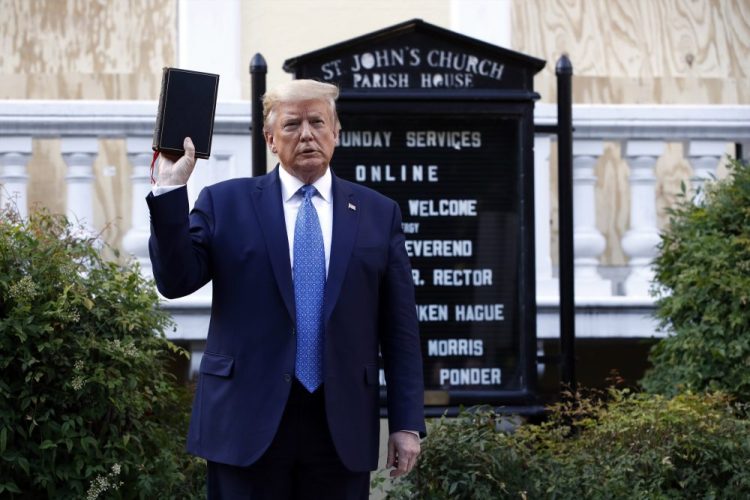WASHINGTON — During the nearly two weeks since authorities charged at peaceful protesters to push them from D.C. streets – about 30 minutes before President Trump walked through the area for a photo op – his aides, the attorney general and federal law enforcement officials have sought to shield the president from political fallout with a simple defense: One scene, they say, had nothing to do with the other.
The notion that the street-clearing offensive around Lafayette Square was already planned, and separate from Trump’s decision to visit a nearby church, has emerged as the administration’s central explanation for scenes of federal officers shoving protesters with shields and firing pepper balls, chemical grenades and smoke bombs at retreating crowds on June 1.
“This was not an operation to respond to that particular crowd. It was an operation to move the perimeter one block,” Attorney General William Barr told CBS News last week.
However, the accounts of more than a half-dozen officials from federal law enforcement, D.C. public safety agencies and the National Guard who were familiar with planning for protests outside the White House that day challenge that explanation. The officials told The Washington Post they had no warning that U.S. Park Police, the agency that commanded the operation, planned to move the perimeter – and protesters – before a 7 p.m. citywide curfew, or that force would be used.
Among them is D.C. Police Chief Peter Newsham, who said that while there had been discussions about possibly pushing the perimeter farther outward from the White House, there was not a confirmed time to do so. He noted that authorities did not actually secure the area with fencing until hours after protesters were cleared.
“When they extended the perimeter, it was overnight,” he said.
Newsham said that his agency, which did not take part in the Lafayette Square operation, learned via police communications that force was going to be used to clear the protesters just moments after he and other officials were told that Trump would be walking to the church.
“We heard that there was going to be an unscheduled presidential movement,” Newsham said. “Just a few minutes later, our teams on the ground learned (chemical) munitions were going to be used. The munitions were deployed minutes later.”
Another D.C. public safety official, who spoke on the condition of anonymity to discuss the operation, said it was as if the Park Police plan to move the perimeter had been “hurried up” around the time the president decided to walk to the church. The clearing of the area began just after 6:30 p.m., and Trump left the White House for the church about 7:02 p.m.
Gen. Joseph Lengyel, chief of the National Guard Bureau, said he was stunned to watch the scenes of protesters fleeing officers on television that evening.
“I never heard any plan, ever, that police or National Guard were going to push people out of Lafayette Square,” said Lengyel, a member of the Joint Chiefs of Staff.
U.S. Park Police acting chief Gregory Monahan said in a statement to The Post that the timing and tactics were in response to what he said was violence by demonstrators.
Monahan said the operation to secure the street and install the fence “had been discussed as early as two days prior” and was “completely irrespective” of the president’s later movement, which he said his agency did not know about.
Moving the perimeter, Monahan said, “was contingent upon having enough resources on scene. Given that the majority of law enforcement personnel did not report until later in the day, a late afternoon or early evening operation was inevitable.”
The Park Police did not respond to questions about what time the fencing was eventually installed.
A spokeswoman for the Secret Service declined to comment, referring questions to Monahan.
Justice Department spokeswoman Kerri Kupec said protesters were not moved to accommodate the president’s walk to the church. “The decision to move the perimeter was made well before there was any plan for the President to leave the White House,” she said in a statement.
A White House spokesman did not respond to a list of questions.
Trump has repeatedly played down the use of force that federal authorities deployed to clear the streets. “The protesters, agitators, anarchists (ANTIFA), and others, were handled VERY easily by the Guard, D.C. Police, & S.S. GREAT JOB!” he tweeted Thursday.
A senior administration official said Trump wanted protesters pushed farther away from the White House beginning that Monday morning. Throughout the day, White House Chief of Staff Mark Meadows and Barr had a series of conversations about moving the perimeter, long before the president decided to walk across Lafayette Square, according to the official, who, like several others interviewed for this report, spoke on the condition of anonymity to describe internal conversations.
Photos and videos of protesters being hit with riot-control grenades as they were forced from streets around Lafayette Square, a historic site for protesters exercising their First Amendment rights, has elicited sharp criticism from former military leaders and apologies from the Pentagon’s top general for his presence at the scene, and spurred multiple calls for investigations.
Comments are not available on this story.
Send questions/comments to the editors.


